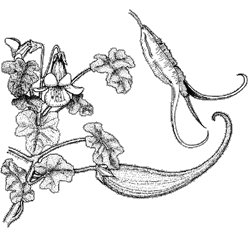Pedaliaceae (sesame family)
(the family Martyniaceae is included here)
Within a small family of less than 100 species; the genus Proboscidea (also called Martynia) has but 9 species in tropical America and 2 in the Sonoran Desert. Many species have woody, hooked fruits that are transported on the fur or feet of large animals. Our local devil’s claws are adapted to catch onto the hooves of deer or other ungulates. The two long, sharp hooks grasp a hoof in such a way that the thick, woody seed-bearing capsule of the fruit is positioned beneath the hoof. As the animal walks, the capsule is ground away and the 20 or so seeds are gradually released over a considerable distance. The fruit hooks hikers’ ankles in the same manner; the sensation of being “grabbed” is startling!
Proboscidea altheaefolia
English names: devil’s claw, unicorn plant, elephant tusks
Spanish names: cuernos (uña) del
diablo (devil’s horns[claw]), espuela del diablo (devil’s spur), gato (cat), campanita (little bell)
Description
This devil’s claw is a prostrate perennial that grows from a large tuberous root. The stems emerge during warm weather in response to rain and produce a mat of sticky foliage. Two-inch (5 cm) bright yellow flowers with deeper yellow streaks are borne on stems above the foliage; they’re sweetly fragrant. The fruit is typical for the genus (see illustration).
Range
Perennial devil’s claw is widespread in much of the Sonoran Desert, including southeastern California, where it sprouts only every few years, west to Texas and south to Sinaloa; it is also found in Peru. It grows mostly in sandy soils, especially in disturbed places such as washes and road shoulders.
Notes
There are several spellings of the specific epithet in literature, including althaeifolia and altheaiefolia.
Pollination is accomplished by a number of bees, particularly bumblebees and carpenter bees. These large bees barely fit into the flower tube and cannot help but brush against the anthers and stigma on the upper surface of the tube. The small bee Perdita hurdi also pollinates these flowers, but in an odd manner. The pollen ripens before the flower opens. Female Perdita cut a hole in the buds to enter and steal the pollen to provision their nests. They also visit open flowers to get nectar; however, this bee is too small to contact the stigma in the roof of the large floral tube. But male bees are sometimes waiting for a potential mate to show up. While the pair grapples to copulate, the female may touch the stigma and leave some pollen stuck to it. As is the case with ocotillos, what seems like an illegitimate relationship may accomplish pollination after all.
Proboscidea parviflora
English names: devil’s claw, unicorn plant
Spanish names: aguaro, cuernero (horned)
 |
Description
This devil’s claw is a summer annual to 2 feet (60 cm) tall and 2 to 3 times as wide with large, ill-smelling, sticky foliage. The 1-inch (2.5 cm) flowers, purplish with yellow spots, are nearly hidden beneath the foliage. The distinctive fruit is typical of the genus.
Range
It is distributed in semiarid habitats from Arizona to Texas, south to central Mexico. Found mostly in disturbed soils, it’s a common weed in agricultural areas.
Notes
The variety hohokamiana is a cultivar developed by the O’odham. It differs from the wild type in 2 important ways. The cultivar has claws up to a foot (30 cm) long with softer fibers. The black fibers in the claws are used in basket-making, especially by the Tohono O’odham. The longer, softer fiber in the domesticated claws are easier to work with. Secondly, the seeds of the cultivar are white instead of black, and lack germination inhibitors. While seeds of the wild type must lie in the ground for a couple of years before they will germinate, the white seeds sprout as soon as they get wet in hot weather and are thus easier to cultivate. This is one of the few plants domesticated north of Mexico, and this seems to have been accomplished only late in the last century. There is a theory that the introduction of cattle was the catalyst. Cattle will eat devil’s claw plants, and O’odham women may have been forced to save seeds and grow them in more protected areas than previously. Among the saved seeds was a variant with longer claws and white seeds. The cultivar is now grown by more than 25 native cultures, some of whom live far beyond the natural range of the wild devil’s claw.
The same Perdita bee that visits P. altheaefolia also visits the cultivar, but not the wild type of annual devil’s claw. This is probably a result of the cultivar having paler flowers, which might be mistaken for the yellow flowers of the perennial species. The seeds and young fruits are edible.
In the tropical deciduous forest south of the Sonoran Desert is another species, Proboscidea louisianica fragrans (syn. P. sinaloensis) that looks the same vegetatively. But its larger, more colorful, and fragrant flowers are borne above the leaves. It ranges into the southeastern U.S.










